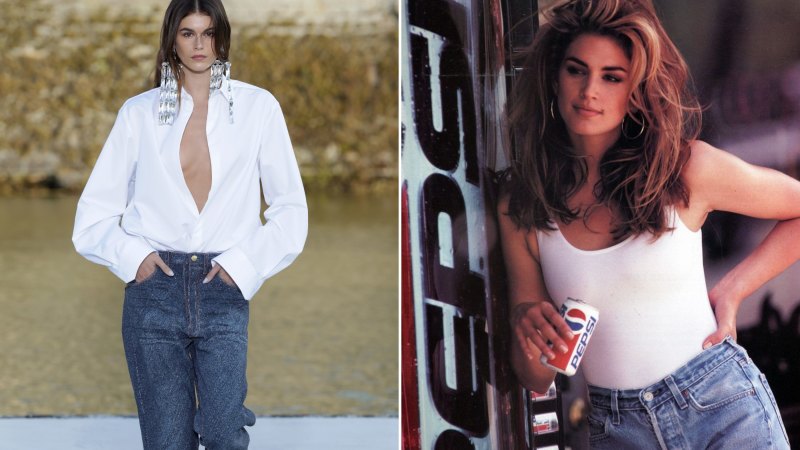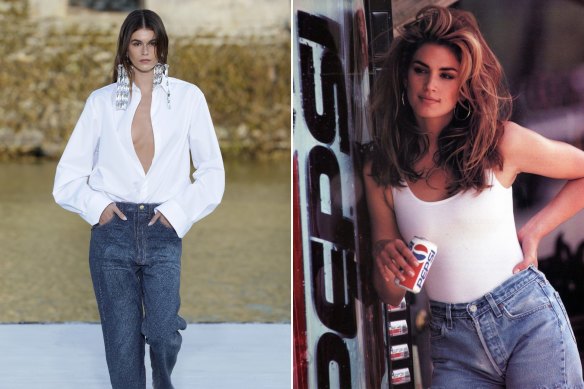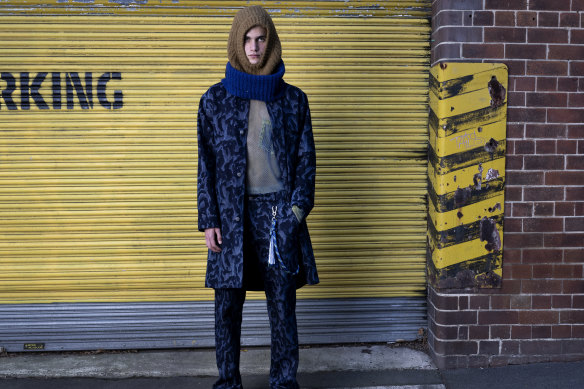Save articles for later
Add articles to your saved list and come back to them any time.
More than 20 years after her mother Cindy Crawford made affordable denim cut-off shorts desirable in a 1992 Pepsi commercial, supermodel Kaia Gerber has given jeans a luxury upgrade.
During this month’s haute couture season in Paris, where intricate gowns command prices upwards of $100,000, Gerber opened the Valentino show in the grounds of the Château de Chantilly wearing a deceptively simple-looking pair of jeans with a white shirt.
Supermodel Kaia Gerber opens the Valentino autumn 23 haute couture show in blue jeans; Cindy Crawford in denim cut-off jeans for Pepsi in 1992.Credit: Getty, Pepsi
The Levi’s cut-off style worn by Crawford can be purchased today for $119, but Gerber’s Valentino silk gazar jeans, hand-embroidered with glass beads dyed 80 shades of indigo, would break most blue-collar budgets.
A price for Valentino’s haute couture jeans is not available (if you need to ask, you probably can’t afford them), but you can pick up ankle-tickling, feather-trimmed denim from their more accessible ready-to-wear collection for $4100. If you’re stuck on gem-encrusted jeans, Italian label Golden Goose has pairs for $1920, complete with pre-torn knees.
At Balenciaga, creative director Demna pushed the trompe l’oeil jeans trend further with a $US27,000 ($39,627) canvas version, painted with oil, while at Jean Paul Gaultier, guest designer Julien Dossena dreamed up beaded jeans with an elaborate train.
“In Paris, buyers are looking for denim as part of their key fashion stories of the season,” says Melvin Tanaya, co-creative director of Australian label Song For The Mute. “They want the more expensive denim pieces. It’s no longer just a sideline to the main collection.”
Tanaya and Lyna Ty launched Song For The Mute in 2010 but only began making denim pieces two years ago. Now, with jeans priced above $1000, denim is their most popular category, sold internationally at Selfridges, Harvey Nichols and Lane Crawford.
Australian luxury label Song For The Mute is pushing boundaries with denim, worn by model Jesse Stuart. Song For The Mute denim coat, $2295 and zip up pants, $1195.Credit: Louise Kennerley
“Our price point was already quite high, so we had to find a way to work with denim that our customers would understand,” Tanaya says.
Ty started with unique treatments that drew inspiration from ’90s acid wash, giving heavyweight Japanese denim a foggy effect. Collections have progressed to denim burnt through with chemicals for a deliberately imperfect result.
“Denim may have been seen as streetwear and more affordable, but it has been put on the top echelon of fabrics,” Tanaya says. “We treat it like a luxury fabric, thinking abut hand-feel and drape.”
“If it looks vintage, then you have gone too far. Someone can go out and buy a vintage pair of jeans easily. This has to look different and have that feeling of newness.”
Intellectualised denim pieces by Sydney designer Christopher Esber – a favourite of Zendaya, Margot Robbie and Gemma Ward – are becoming almost as well-known as his crisp cut-out dresses and twisted fabric details.
“The idea of reconstructing denim icons is something we consider each season,” says Esber, who sells deconstructed jeans for $540. “There is a sense of ease when it’s offset or contrasted by something serious or glamorous, but it still feels elevated.”
“Our moss-coloured denim is actually a raw denim that has only been washed at the edges of seams. Our idea was to invert the traditional washed denim effect that occurs around pockets and waistbands, to create a tonal effect, which reflects denim’s truest and rawest hue.”
Next month, sustainable fashion champion Bassike will relaunch its elevated denim range with pieces produced in Australia using Japanese fabric.
“The garments are meticulously crafted and washed in Australia, resulting in a beautifully unique garment,” says Bassike creative director and co-founder Deborah Sams. “All elements are considered, even down to tiny details such as stitch type, length, and colour.”
For the time being, international and Australian designers are sticking to a relaxed, straight-leg style but for those willing to spend big on calf-hugging skinny jeans currently banished from the zeitgeist, there’s a bedazzled glimmer of hope.
“We never rule out anything as a possibility for future collections,” Sams says, “Skinny jeans still have a place, it’s all about the timing.”
Make the most of your health, relationships, fitness and nutrition with our Live Well newsletter. Get it in your inbox every Monday.
Most Viewed in Lifestyle
From our partners
Source: Read Full Article


